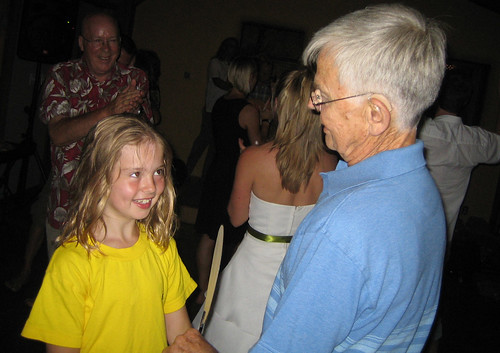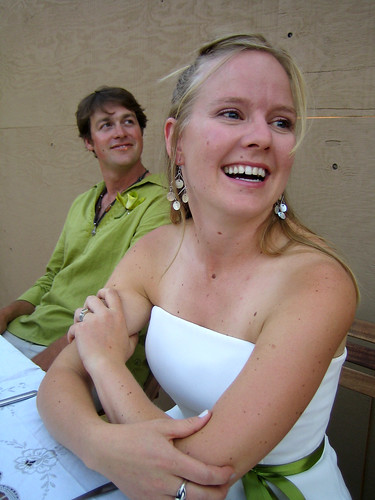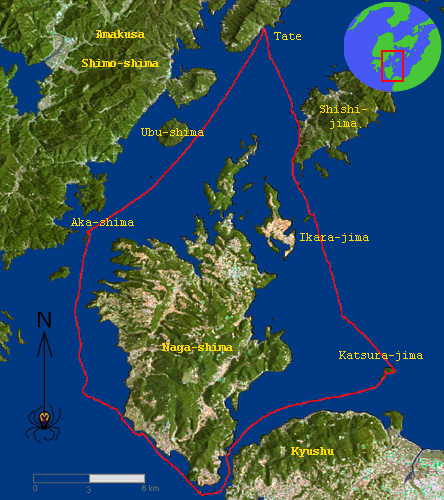
Tate hamlet, Monday, July 2nd, 5a.m. The sun hasn’t yet risen, but an obnoxiously long electronic tune comes blaring over the rooftops from the ubiquitous public announcement speakers. We’re here at this ungodly hour to catch the tide. Nothing stirs in the village as the tune finally comes to an end. Peasants awake, it’s time to work! Yet another bizarre way the country’s ancient customs have intertwined themselves with modern technology. Certainly, the term ‘noise pollution’ is utterly beyond understanding in Japan.
Soon we are on the water. This weekend’s 72km tour, thought of as mild training for our upcoming summer vacation in Okinawa, will take us around the island of Nagashima to the tiny island of Katsura-jima, the smallest inhabited island in these parts. While we’ve paddled these waters a-plenty, we’ve never visited Katsura-jima before, because it lies somewhat out of the way to the east of our usual paddling routes. Internet searches about this island were sketchy, and we know only that 25 people live there and there is no ferry or facilities of any kind, in spite of which mainlanders seem to come camping occasionally in the summer. From our experience however, this kind of incomplete and conflicting information usually indicates a quality destination, so we set out today with some anticipation and excitement.
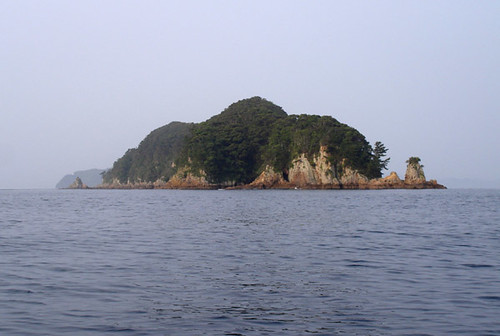 Aka-shima.
Aka-shima.We make a brief stop on Aka-shima, a small sliver of an island wedged diagonally in the narrowest part of the Nagashima Strait. At spring tide, the sea roars past here at 6 knots or more, and the ends of the island shed some mean eddy lines – lately we have been using these to practice various maneuvers. Today, the tide is milder and we take an early break here in the morning sunshine.

I climb a short ways up the steep slope to the islet’s spine, where the undisturbed nature is a pleasure to look at.
Soon we are off again. From here we head south to where the strait opens out into the East China Sea. Some swell is rolling in from the south while the outgoing currents swirl in complex ways. Without detailed knowledge, using the currents to one’s advantage is difficult and today we take measurements on the way, in an effort to form a coherent picture of the water’s movements.
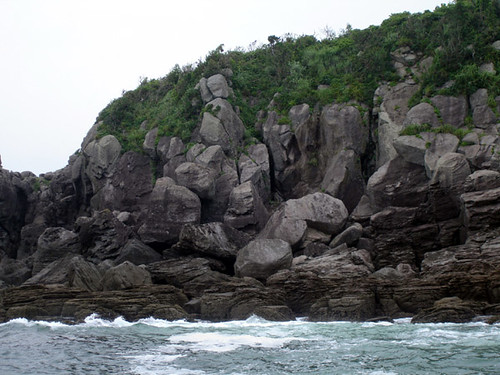 Tatara-jima rock formations.
Tatara-jima rock formations.After another rest in a nondescript concrete port, we pass the southernmost point of Naga-shima. Here, a small rocky island called Tatara-jima is battered by the swell concentrated around the headland. Carefully navigating around the booming shoals, we enter the Kuronoseto, a narrow passage leading back into the Yatsushiro bay. The tide has turned in the meanwhile and we enjoy a tail current all the way to Katsura-jima, where we arrive in the early afternoon.
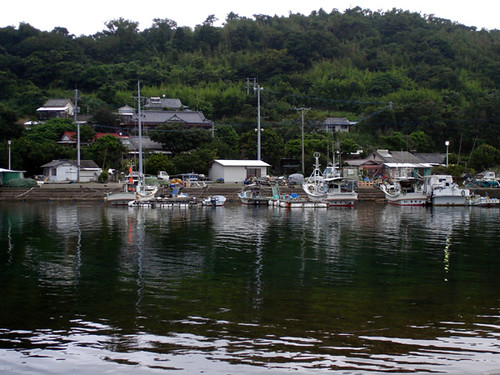
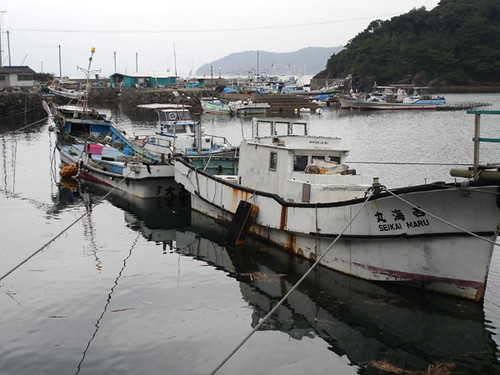
As we pull up in the tiny old port, we see that this place is as backwater as can be. Half-sunken boats await complete decomposition along with rotting ropes and nets.
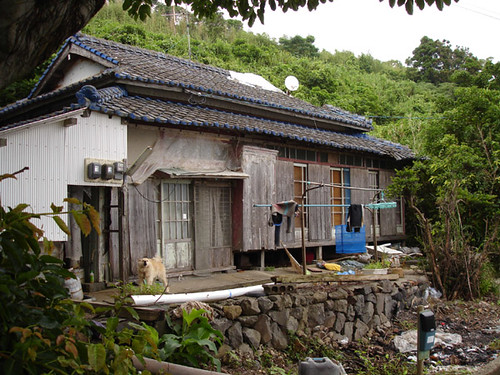
On shore, the same might be said of a good portion of the houses. Amongst this decay, however, a few houses remain in a decent state of repair, with narrow paths cleared for access through the junk and weeds. Where the paths get steep the locals have set up boards with transverse slats to walk on – on the moldy, damp concrete underneath one would surely slip. There is even a school here, but it seems deserted on what ought to be a school day. The whole place seems about the right size for its population of 25 – that is, tiny.
 Cats are everywhere, outnumbering the human population by a factor of at least five or ten.
Cats are everywhere, outnumbering the human population by a factor of at least five or ten.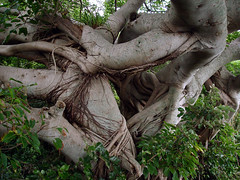 Banyan trees line the coast in the village.
Banyan trees line the coast in the village.Outside the cluster of houses, the rest of the island is an impassable jungle, although concrete walls connect it with two more islets where a path affords a remarkably pleasant walk amongst some beautiful tall pine trees.
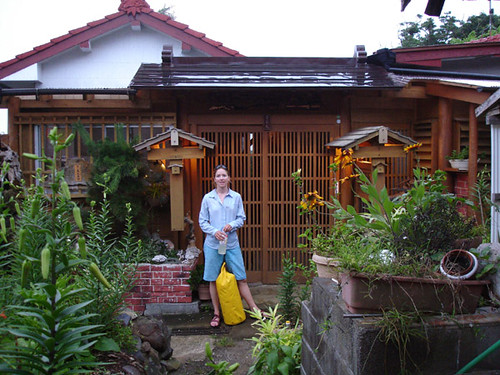 Our private cottage on Katsura island.
Our private cottage on Katsura island.Needless to say, it takes no time before we are noticed by the local residents, who express some interest in our kayaks. With no one in a hurry in a place like this, we are engaged in long friendly conversations about nothing in particular. A hospitable fisherman and his wife soon show their generosity by putting us up in a luxuriant house that the man has built ‘as a hobby’, decorating it with much pine wood from local trees downed by typhoons. It’s a kind of guest house, they say, where they welcome any visitors to the island; they don’t charge any money. Anyway, they say, it’s much better than camping, as there are many mosquitoes. At this point, we’re not sure what to believe, but we graciously accept to stay and take a shower to wash off the sticky salt and sweat off our bodies (the island has electricity and water provided by cables and pipes from the mainland).
By evening, having explored everywhere one can walk, we retire to our house just as heavy rain showers pour down. We read books and magazines until it’s time for bed; we sleep like rocks through the dark, rainy night.
Before seven the next morning, the rain and wind have stopped and we are already making preparations for our return trip. We have a tide to catch and have to be at work from three in the afternoon. Our fisherman host is already (or still) up, having worked through the night, and two women stack nets in their small boat, getting ready to go out. We say goodbye to these friendly, relaxed, commonsense people and promise we will someday return.
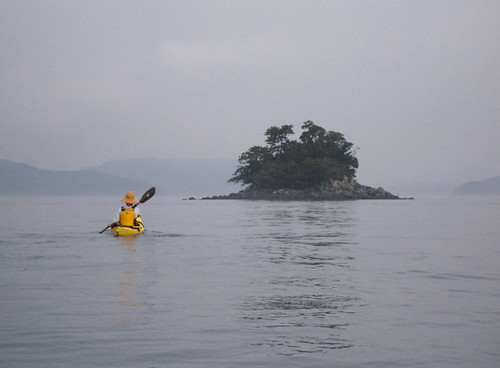 Apporaching Nanao-jima.
Apporaching Nanao-jima.The way back is a nearly straight line, much of it crossing open water. Along the way we enjoy the sight of several tiny islands such as Nanao-jima. Islands such as this, really just rocks big enough to support a few trees and some brush, are remarkably common in Amakusa. The twisted trees clinging to the rocks give the impression of a full-size bonsai garden.
Mist thickens into a fog-like consistency towards noon and we are on a state of alert as we make the crossing of Hachiman Strait, a fairly busy shipping channel. A foghorn sounds repeatedly from the south, and finaly an enormous Panamanian freighter emerges from the mist on our left. Although we know we are already out of its way, its sheer bulk and the huge bulge of water being pushed ahead of its prow seem intimidating; we feel a tug from our primal instinct to flee. But we hold still and watch it pass. We notice how a kind of fisheye lens perspective effect makes the behemoth look like it’s turning or bending as it passes us. It draws away quickly and disappears again into the mist while we paddle towards shore to resume, for a while, our ordinary lives.
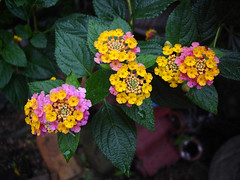


 My sister lives in Nakusp, which is a small town of only 1800 people. Set in the mountains on a lake, Nakusp is a gorgeous place to live.
My sister lives in Nakusp, which is a small town of only 1800 people. Set in the mountains on a lake, Nakusp is a gorgeous place to live.